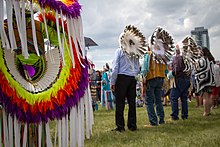War bonnet

War bonnets (also called warbonnets or headdresses) are
Ceremonial importance

Many Native American tribes consider the presentation of an eagle feather to be one of the highest marks of respect. An honored person must have
While women have traditional regalia that can include other types of
Due to their historical importance and status, traditional Native Americans now consider the wearing of headdresses without the express permission of tribal leaders to be an affront to their culture and traditions.[4][5] Consequently, in cases where non-Native political leaders have been symbolically allowed to wear the headdress, this has caused controversy.[3]
Legality
Plains-style war bonnets are made out of eagle feathers because the eagle is considered by most tribes of the Interior Plains to be the greatest and most powerful of all birds. Under current United States federal legislation, the eagle feather law enables Native Americans to continue using eagle feathers in their traditional spiritual and cultural practices. The exemption is contained within the Migratory Bird Treaty Act of 1918. In the United States, only enrolled members of a federally recognized Native American tribe may legally collect or possess eagle feathers.[6]
One traditional method of acquiring feathers for war bonnets is to pluck the most mature tail feathers of young eagles while still in the nest. This can be done three times before the feathers do not grow back. As many as thirty-six feathers can be collected in this manner. If care is taken in not disturbing the nest, this method can be repeated yearly.[7]
Plains-style bonnets
Plains Indians use eagle feathers as the most significant part of the headdress to represent honor and respect. Some Plains-style bonnet forms are the "horned" bonnet, "flaring" eagle feather bonnet, and the "fluttering feather" bonnet. The "horned" bonnet can consist of a buckskin skull cap, shaved bison or cow horns, and dyed horsehair with bunches of owl feathers beneath the skull cap. The "flaring" eagle feather bonnet is often made of golden eagle tail feathers connected to a buckskin or felt crown. There are slits at the base of the crown that allow the bonnet to have a "flaring" look. An unusual form of bonnet is the "fluttering feather" bonnet, with the feathers loosely attached to a felt or buckskin cap, hanging at the sides.[8]
Cultural appropriation
Native American cultural representatives and activists have expressed offense at what they deem the cultural appropriation of wearing and displaying of such headdresses, and other "indigenous traditional arts and sacred objects" by those who have not earned them, especially by non-
To explain Native peoples' discomfort with non-Indians wearing headdresses, for example, it is necessary to go back to the indigenous perspective and evaluate what the headdress means specifically to the various tribes, Crow and Lakota to name two, that make and use them. Without such context, it's impossible for non-Indians in contemporary settings to grasp the offense and harm that indigenous people feel when sacred objects and imagery are co-opted, commercialized, and commodified for non-Indians' benefit.[19]
See also
Notes
Citations
- ISBN 978-0-8061-1577-1.
- ^ ISBN 0-87081-347-1.
- ^ a b Behind First Nations headdresses: What you should know
- ^ Indian Country Today Media Network. Archived from the originalon July 6, 2017. Retrieved April 20, 2015.
On imitation Native headdresses as "the embodiment of cultural appropriation ... donning a highly sacred piece of Native culture like a fashion accessory
- ^ a b c Keene, Adrienne (April 27, 2010) "But Why Can’t I Wear a Hipster Headdress? Archived May 13, 2016, at the Wayback Machine" at Native Appropriations – Examining Representations of Indigenous Peoples.
- ^ "Eagle Permits - Native American Feather Permit". www.fws.gov.
- ISBN 9781933316604.
- JSTOR 25666195.
- ^ "This means war: why the fashion headdress must be stopped". The Guardian. July 30, 2014.
- ^ "Ricky Martin Accused of Cultural AppropriationAfter Posting Headdress Photo". USA Today. Nov 29, 2018.
- ^ "Coachella Attendee Apologizes for Culturally Appropriating a Native American Headdress". Teen Vogue. April 27, 2017.
- ^ "HERE'S WHY YOU SHOULDN'T WEAR A NATIVE AMERICAN HEADDRESS". MTV. June 4, 2014.
- ^ a b "ReMatriate was started earlier this year by women from the Yukon and northern B.C. in response to offensive runway fashion shows and “festival wear” appropriated from indigenous traditional arts and sacred objects and sold as commodities without permission." See "Northern-sparked 'ReMatriate' campaign takes on cultural appropriation". Northern Journal. May 4, 2015. Archived from the original on 2021-01-15. Retrieved 2016-10-08.
- ^ "Still experiencing a cultural genocide". BBC News. May 13, 2016.
- ^ "Pharrell Apologizes for Wearing Headdress on Magazine Cover". Rolling Stone. June 5, 2014. Retrieved 2015-11-09.
- ^ "No More War Bonnets at Glastonbury Music Festival". Lakota Law Project. October 17, 2014. Retrieved 2016-10-08.
- ^ Rota, Zack (29 July 2014). "Why Native Headdresses No Longer Belong at Music Festivals".
- ^ "Osheaga Issues Ban on Headdresses as Fashion Accessories". exclaim.ca.
- ^ Riley, Angela R.; Carpenter, Kristen A. (1 April 2016). "Owning Red: A Theory of Indian (Cultural) Appropriation". Texas Law Review. 94 (5): 915.
Bibliography
- Hardin, Barry E. (2013). The Plains Warbonnet: Its Story and Construction. Book Publishing Company. ISBN 9781929572236.
- Hirschfelder, Arlene; Molin, Paulette F.; Wakim, Yvonne; Dorris, Michael A. (1999). American Indian Stereotypes in the World of Children: A Reader and Bibliography. Scarecrow Press. ISBN 9781461656302.
- Waldman, Carl (2014). Encyclopedia of Native American Tribes. Infobase Publishing. ISBN 9781438110103.
